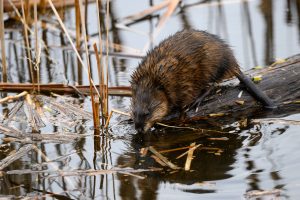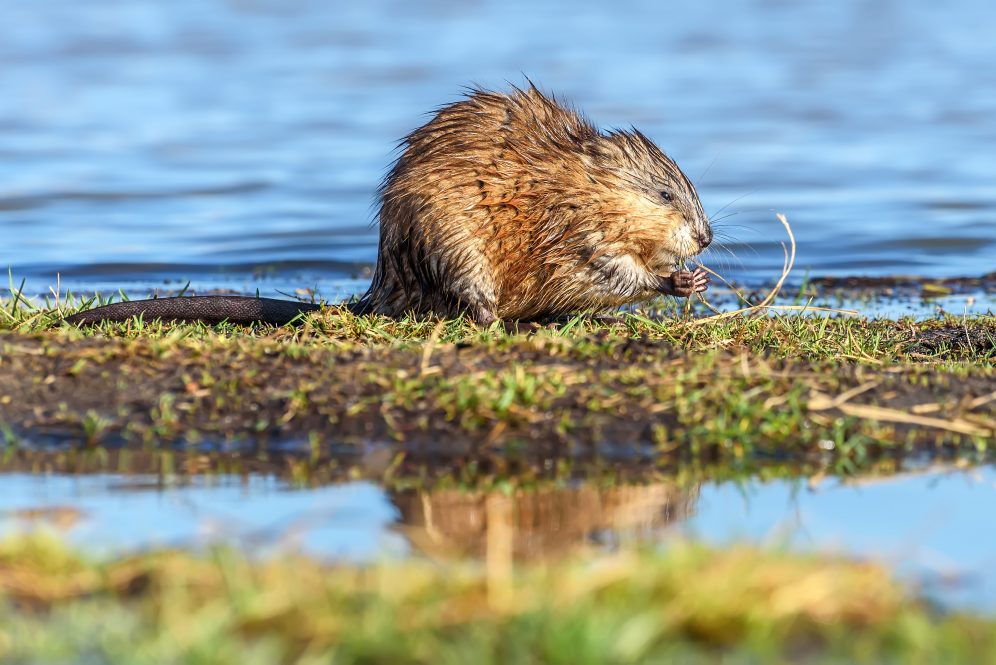In his speech for the College of Agriculture, Health and Natural Resources (CAHNR) this past spring, keynote speaker Rodney Butler ’99 (BUS), Chairman of the Mashantucket Pequot Tribal Nation, told an abbreviated version of the Indigenous creation story of Skywoman.
“When the world was covered in water, Skywoman fell from an opening in the Skyworld and landed on the back of a giant turtle. Skywoman enlisted the help of many animals to dive deep to retrieve soil from the depths of the ocean in an effort to create land. Many animals attempted to grab the soil, but it was the unlikely muskrat, who was both humble and courageous, that was able to return the soil and place it on the back of the great turtle. As the mud is placed on the turtle’s back, it grows and expands, eventually forming the continents and life-sustaining world we know today.”
Butler spoke of how the story emphasizes the importance of working together and that we are all better when we work and learn together. There is also great strength in partnering Indigenous knowledge with science to build a sustainable future.
Associate Professor Beth Lawrence has a joint appointment with the Center for Environmental Science and Engineering and the Department of Natural Resources and the Environment in CAHNR, and her work adds to the time-honored appreciation of the courageous and humble muskrat. In research published in Freshwater Science, Lawrence and collaborators, including project lead Shane Lishawa and Andrew Monks from Loyola University, and Danielle Fegan and Eric Clark, who are biologists with the Sault Ste. Marie Tribe of Chippewa Indians, describe how muskrats engineer more biologically diverse marsh ecosystems.
The researchers study cattail-dominated marshes and strategies to create more varied, or heterogeneous, ecosystems using methods like mechanical harvesting or by applying herbicides. While out on field research, Lawrence says they made an intriguing observation.
“We noticed in some years that muskrats were doing naturally what we were doing with our aquatic weed whackers and gas-powered equipment. We thought that maybe we should investigate how muskrats alter cattail and associated species,” says Lawrence.
The project focused on a marsh that connects the St. Mary’s River outlet of Lake Superior to Lake Michigan and Lake Huron. In vast marshes like this one, the non-native cattail species Typha can take over and make acres of marshland look similar to cornfields in terms of the lack of diversity, says Lawrence. These kinds of monocultures do not support biologically diverse ecosystems.
“It homogenizes the wetland, and is not an ideal habitat for birds, macro-invertebrates, fish, and native plants, so over the last 15 years we’ve been interested in how we can manage these invaded cattail marshes of the Great Lakes,” Lawrence says.
The researchers have tried a variety of methods to control the cattails, but they are most interested in using mechanical means, rather than chemical control measures.
“Cutting the cattail at different intensities and frequencies can reduce its abundance and promote native diversity and also open up habitat that creates heterogeneity in these monotypes. This promotes species diversity overall, and improves habitat for native fish and bird communities,” says Lawrence.
Muskrats are semi-aquatic rodents that naturally harvest cattails by cutting them below the water level. This is important because the stems of the plant act almost like a snorkel to provide oxygen to the roots. Cutting stems below the water essentially drowns the cattail by severing the connection between the oxygen-rich atmosphere and the anoxic sediment common to wetlands. The muskrats use the cattails to build their lodges, and the process creates openings that give other plant species a chance to grow.

Using drones and aerial photography, the researchers identified several lodges and openings where they sampled the vegetation and water quality parameters. They also harvested cattails via mechanical methods or with herbicides to create muskrat disturbance analogs (MDAs) to simulate the muskrat openings. They compared these data with data collected from adjacent non-muskrat-impacted areas.
“Then we monitored the vegetation and water quality parameters for two growing seasons after that. We found there was greater biodiversity with the muskrat disturbances and the MDA treatments,” says Lawrence.
The muskrats and the MDA methods reduced the presence of the cattails as well as another invasive plant called European frogbit (Hydrocharis), therefore they helped promote more heterogenous communities and the authors note that efforts to increase muskrat populations should be taken as a management strategy in areas where these two invasive plant species dominate.
“Restoring biodiversity is critical to our future. Climate change is happening rapidly, and we’re rolling the dice. Maintaining and protecting a diversity of species is important because we don’t know which species will survive or thrive in different climate scenarios,” says Lawrence. “I think of Aldo Leopold’s quote about how an intelligent tinkerer always keeps all the parts. We want to keep all of the parts of the planet because we don’t know exactly what the future is going to look like.”
Lawrence also has projects focusing on beavers, which are also vital ecosystem engineers. Like muskrats, beavers transform habitats and act as keystone species that play an important role in creating wetland habitats,
“These important aquatic rodents transform habitats in many ways that some communities, like the Native Americans, have appreciated for 1000s of years, and Western science is just now discovering that importance. Beavers are resurging on the landscape after being almost extirpated in New England due to hunting. They were reintroduced after being essentially extinct in Connecticut about 200 years ago and then reintroduced about 100 years ago. Now, their populations are exploding, and they’re transforming our landscape again.”
Lawrence also reflects on the significance of teamwork in this project:
“I think science takes a team. Our relationship with the tribe and across institutions is a big part of the importance of this paper and this project. It was a really satisfying project, both in terms of the relationships that have developed over the years, but also how we’ve gained a lot of insights by studying the system over decades.”



